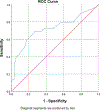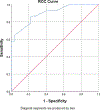The Sickness Behavior Inventory-Revised: Sickness behavior and its associations with depression and inflammation in patients with metastatic lung cancer
- PMID: 33222717
- PMCID: PMC8311665
- DOI: 10.1017/S1478951520001169
The Sickness Behavior Inventory-Revised: Sickness behavior and its associations with depression and inflammation in patients with metastatic lung cancer
Abstract
Background: Inflammation may contribute to the high prevalence of depressive symptoms seen in lung cancer. "Sickness behavior" is a cluster of symptoms induced by inflammation that are similar but distinct from depressive symptoms. The Sickness Behavior Inventory-Revised (SBI-R) was developed to measure sickness behavior. We hypothesized that the SBI-R would demonstrate adequate psychometric properties in association with inflammation.
Method: Participants with stage IV lung cancer (n = 92) were evaluated for sickness behavior using the SBI-R. Concomitant assessments were made of depression (Patient Hospital Questionniare-9, Hospital Anxiety and Depression Scale) and inflammation [C-reactive protein (CRP)]. Classical test theory (CTT) was applied and multivariate models were created to explain SBI-R associations with depression and inflammation. Factor Analysis was also used to identify the underlying factor structure of the hypothesized construct of sickness behavior. A longitudinal analysis was conducted for a subset of participants.
Results: The sample mean for the 12-item SBI-R was 8.3 (6.7) with a range from 0 to 33. The SBI-R demonstrated adequate internal consistency with a Cronbach's coefficient of 0.85, which did not increase by more than 0.01 with any single-item removal. This analysis examined factor loadings onto a single factor extracted using the principle components method. Eleven items had factor loadings that exceeded 0.40. SBI-R total scores were significantly correlated with depressive symptoms (r = 0.78, p < 0.001) and CRP (r = 0.47, p < 0.001). Multivariate analyses revealed that inflammation and depressive symptoms explained 67% of SBI-R variance.
Significance of results: The SBI-R demonstrated adequate reliability and construct validity in this patient population with metastatic lung cancer. The observed findings suggest that the SBI-R can meaningfully capture the presence of sickness behavior and may facilitate a greater understanding of inflammatory depression.
Keywords: C-reactive protein; Depression; Inflammation; Lung cancer; Sickness Behavior Inventory.
Conflict of interest statement
Figures
Similar articles
-
Measuring sickness behavior in the context of pancreatic cancer.Med Hypotheses. 2015 Mar;84(3):231-7. doi: 10.1016/j.mehy.2015.01.002. Epub 2015 Jan 14. Med Hypotheses. 2015. PMID: 25659492 Free PMC article.
-
Evaluating the construct validity and internal consistency of the Sickness Questionnaire in a Swedish sample of adults with longstanding pain.Scand J Pain. 2021 Dec 19;22(1):88-96. doi: 10.1515/sjpain-2021-0070. Print 2022 Jan 27. Scand J Pain. 2021. PMID: 34931508
-
Psychometric properties of the Chinese version of the Center for Epidemiologic Studies Depression Scale-Revised in patients with cancer: A cross-sectional study.Int J Nurs Stud. 2019 Sep;97:14-20. doi: 10.1016/j.ijnurstu.2019.04.008. Epub 2019 Apr 19. Int J Nurs Stud. 2019. PMID: 31129444
-
Proinflammatory cytokines and sickness behavior: implications for depression and cancer-related symptoms.Oncol Nurs Forum. 2008 Sep;35(5):802-7. doi: 10.1188/08.ONF.802-807. Oncol Nurs Forum. 2008. PMID: 18765326 Review.
-
From inflammation to sickness and depression: when the immune system subjugates the brain.Nat Rev Neurosci. 2008 Jan;9(1):46-56. doi: 10.1038/nrn2297. Nat Rev Neurosci. 2008. PMID: 18073775 Free PMC article. Review.
Cited by
-
C-Reactive Protein as a Biomarker for Major Depressive Disorder?Int J Mol Sci. 2022 Jan 30;23(3):1616. doi: 10.3390/ijms23031616. Int J Mol Sci. 2022. PMID: 35163538 Free PMC article. Review.
References
-
- American Psychiatric Association (2013) Diagnostic and Statistical Manual of Mental Disorder, 5th ed. Arlington, VA: American Psychiatric Association.
-
- Anderson G, Berk M and Maes M (2014) Biological phenotypes underpin the physio-somatic symptoms of somatization, depression, and chronic fatigue syndrome. Acta Psychiatrica Scandinavica 129(2), 83–97. - PubMed
-
- Anisman H, Merali Z, Poulter MO, et al. (2005) Cytokines as a precipitant of depressive illness: Animal and human studies. Current Pharmaceutical Design 11(8), 963–972. - PubMed
-
- Bjelland I, Dahl AA, Haug TT, et al. (2002) The validity of the hospital anxiety and depression scale. An updated literature review. Journal of Psychosomatic Research 52(2), 69–77. - PubMed
-
- Capuron L, Gumnick JF, Musselman DL, et al. (2002) Neurobehavioral effects of interferon-alpha in cancer patients: Phenomenology and paroxetine responsiveness of symptom dimensions. Neuropsychopharmacology 26(5), 643–652. - PubMed
Publication types
MeSH terms
Grants and funding
LinkOut - more resources
Full Text Sources
Medical
Research Materials
Miscellaneous





